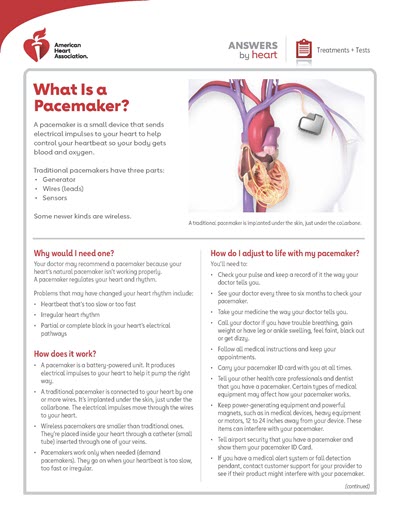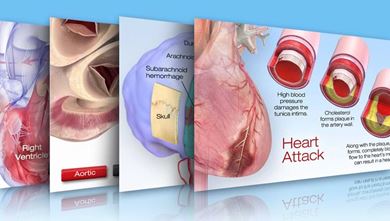Implantable Medical Devices
For Rhythm Control
- Implantable cardioverter defibrillator (Also known as ICD) - An ICD is a battery-powered device placed under the skin that keeps track of your heart rate.
- Pacemaker (Also known as Artificial Pacemaker) - A small battery-operated device that helps the heart beat in a regular rhythm .
To Support the Heart and Circulation
- Left Ventricular Assist Device (Also known as LVAD) - The left ventricle is the large, muscular chamber of the heart that pumps blood out to the body.
Implantable Cardioverter Defibrillator
What the Procedure Does
A device that has wires which are implanted into the heart tissue and can deliver electrical shocks, detect the rhythm of the heart and sometimes "pace" the heart's rhythms, as needed.
Reason for the Procedure
- Used in patients at risk for recurrent, sustained ventricular tachycardia or ventricular fibrillation.
- Restores the heart to normal rhythm.
- Helps prevent sudden cardiac death.
Pacemaker
A temporary pacemaker may be needed after a heart attack during the hospitalization due to have a heart rhythm that is too slow - a pacemaker may not be indicated long term unless damage to the heart's electrical conduction system from the heart attack will impact being able to have a normal heart rhythm and rate.

What the Procedure Does
A small device that has wires which are implanted in the heart tissue to send electrical impulses that help the heart beat in a regular rhythm. The device is powered by a battery.
Reason for the Procedure
When the heart's "natural pacemaker" is defective and causes the heart to beat too fast, too slow or irregularly, a pacemaker helps the heart beat in a regular rhythm.
- Learn more about pacemakers.
- Living with your pacemaker.
- Download a Pacemaker I.D. Card that will tell the people helping you that you have a pacemaker in an emergency.
- What is a Pacemaker? (PDF)
Left Ventricular Assist Device
The left ventricle is the large, muscular chamber of the heart that pumps blood out to the body. The LVAD is a battery-operated, mechanical pump-type device that's surgically implanted. It helps maintain the pumping ability of a heart that can't effectively work on its own.
These devices are available in most heart transplant centers.
When is an LVAD used?
This device is sometimes called a "bridge to transplant," but is now used in long-term therapy. People awaiting a heart transplant often must wait a long time before a suitable heart becomes available. During this wait, the patient's already-weakened heart may deteriorate and become unable to pump enough blood to sustain life. An LVAD can help a weak heart and "buy time" for the patient or eliminate the need for a heart transplant. Most recently, LVADs are being used longer-term as ‘destination therapy’ in end-stage heart failure patients when heart transplantation is not an option.
How does an LVAD work?
A common type of LVAD has a tube that pulls blood from the left ventricle into a pump. The pump then sends blood into the aorta (the large blood vessel leaving the left ventricle). This effectively helps the weakened ventricle. The pump is placed in the upper part of the abdomen. Another tube attached to the pump is brought out of the abdominal wall to the outside of the body and attached to the pump's battery and control system. LVADs are now portable and are often used for weeks to months. Patients with LVADs can be discharged from the hospital and have an acceptable quality of life while waiting for a donor heart to become available.








